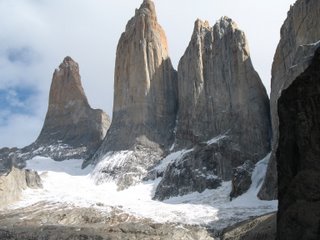Patagonia


I moved onto Torres del Paine national park and spent 4 days trekking there hiking the W (so called due to the shape of the trail). Rather than carrying all the camping gear, I travelled light and stayed at the refugios en route. This turned out to be a good idea as there was rain on some of the days and it didn´t make for great camping weather. The centre of the park comprises a dramatic series of mountains and the W takes you up some beautiful valleys, past glacial lakes, through forests of southern birch and up some strenuous trails towards the peaks themselves. The highlights were the hike to the towering granite pillars of Torres del Paine, the amazing panoramas of the French valley and the hike to glacier grey.





Feeling quite exhausted after all that walking I headed on to El Calafate to see the Perito Moreno glacier, one of the worlds most active. Its part of a much larger mass of ice that is third in size to that in Antartica and Greenland. Even on this cloudy day, the glacier still appears a brilliant blue colour, due to the compactness of the ice which only allows short wavelengths of light to be reflected. The glacier advances two metres daily and small pieces are constantly breaking off, making a thundering sound as the ice falls into the water. It makes for quite a spectacle.


The next stop on the gringo trail through Patagonia is the small town of El Chalten, beautifully located a short distance from the Fitz Roy range. Here the delights are similar to those of Torres del Paine and two tough days of hiking took me up close to the giant granite towers of Cerro Torre and Fitz Roy (at 3450m, Patagonia´s highest peak). I was also very lucky with the weather here, after two weeks of mostly rain, both days trekking were blessed with crystal clear autumn days.


Have just arrived in Bariloche in Argentina´s lake district, after along bus journey north along ruta 40, which took two whole days. Although the road parallels the Andes, it doesn´t have much mountain scenery itself to speak of, just miles and miles of barren treeless Patagonian steppe, with the occaisional small town or estancia on the way. Its these long bus journeys, where you get to appreciate how vast Patagonia is and how isolated some of these small communities are.


0 Comments:
Post a Comment
<< Home